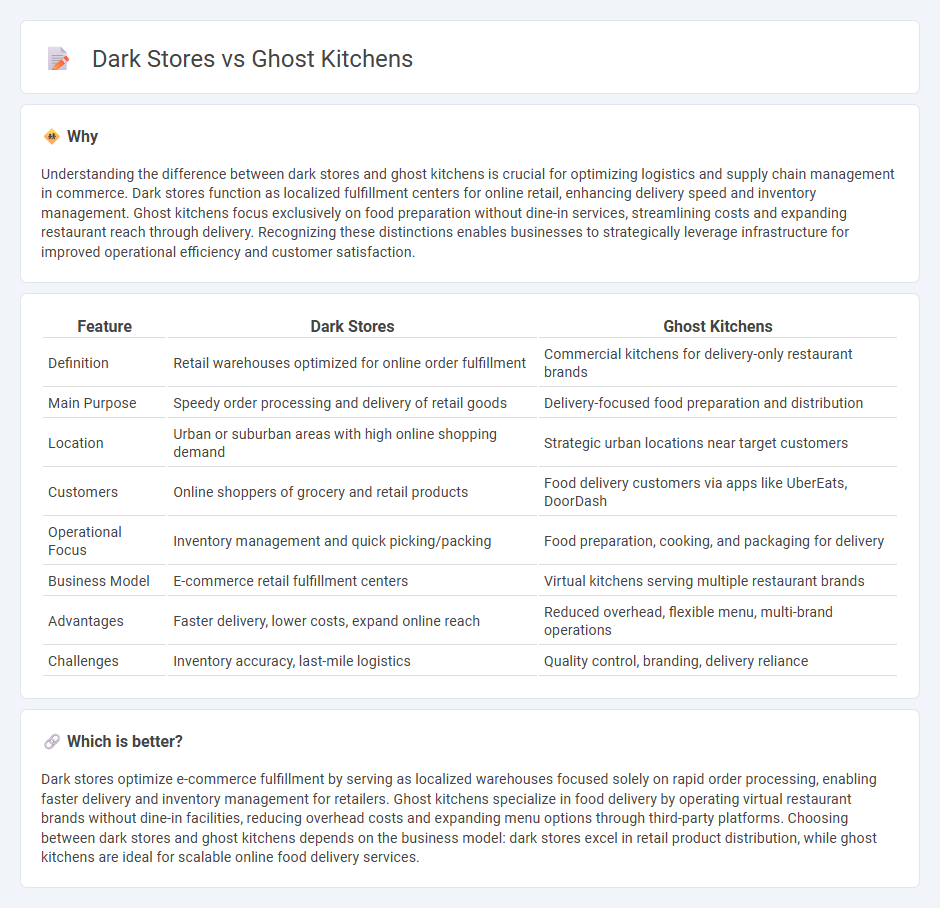
Dark stores optimize e-commerce fulfillment by acting as localized warehouses, enabling faster delivery of groceries and essential goods. Ghost kitchens focus exclusively on virtual food delivery, reducing overhead by eliminating dine-in space and streamlining meal preparation. Explore how these innovative models revolutionize commerce and consumer convenience.
Why it is important
Understanding the difference between dark stores and ghost kitchens is crucial for optimizing logistics and supply chain management in commerce. Dark stores function as localized fulfillment centers for online retail, enhancing delivery speed and inventory management. Ghost kitchens focus exclusively on food preparation without dine-in services, streamlining costs and expanding restaurant reach through delivery. Recognizing these distinctions enables businesses to strategically leverage infrastructure for improved operational efficiency and customer satisfaction.
Comparison Table
| Feature | Dark Stores | Ghost Kitchens |
|---|---|---|
| Definition | Retail warehouses optimized for online order fulfillment | Commercial kitchens for delivery-only restaurant brands |
| Main Purpose | Speedy order processing and delivery of retail goods | Delivery-focused food preparation and distribution |
| Location | Urban or suburban areas with high online shopping demand | Strategic urban locations near target customers |
| Customers | Online shoppers of grocery and retail products | Food delivery customers via apps like UberEats, DoorDash |
| Operational Focus | Inventory management and quick picking/packing | Food preparation, cooking, and packaging for delivery |
| Business Model | E-commerce retail fulfillment centers | Virtual kitchens serving multiple restaurant brands |
| Advantages | Faster delivery, lower costs, expand online reach | Reduced overhead, flexible menu, multi-brand operations |
| Challenges | Inventory accuracy, last-mile logistics | Quality control, branding, delivery reliance |
Which is better?
Dark stores optimize e-commerce fulfillment by serving as localized warehouses focused solely on rapid order processing, enabling faster delivery and inventory management for retailers. Ghost kitchens specialize in food delivery by operating virtual restaurant brands without dine-in facilities, reducing overhead costs and expanding menu options through third-party platforms. Choosing between dark stores and ghost kitchens depends on the business model: dark stores excel in retail product distribution, while ghost kitchens are ideal for scalable online food delivery services.
Connection
Dark stores serve as fulfillment centers for online retail orders, streamlining inventory management and delivery logistics, while ghost kitchens focus exclusively on food preparation without a customer-facing storefront. Both concepts leverage e-commerce and digital ordering platforms to optimize operational efficiency and reduce overhead costs. This integration supports rapid delivery models and meets the growing consumer demand for convenience in commerce.
Key Terms
Fulfillment
Ghost kitchens specialize in preparing food exclusively for delivery, optimizing order fulfillment through advanced kitchen management systems and rapid cooking processes. Dark stores function as fulfillment centers for online grocery and retail orders, streamlining inventory management and rapid packing to ensure speedy delivery. Explore detailed comparisons and best practices for choosing between ghost kitchens and dark stores in efficient order fulfillment.
Delivery-only
Ghost kitchens are delivery-only food preparation facilities operating without a dine-in space, designed to efficiently fulfill online food orders and reduce overhead costs. Dark stores function as localized warehouses for online grocery and retail fulfillment, optimizing quick delivery by storing goods close to customers without serving walk-in shoppers. Explore how these delivery-only models transform the logistics of food and retail by learning more about their impact on urban delivery ecosystems.
Last-mile logistics
Ghost kitchens and dark stores optimize last-mile logistics by streamlining order fulfillment directly from centralized locations, reducing delivery times and minimizing operational costs. Ghost kitchens specialize in food delivery with optimized kitchen layouts and integrated order management, while dark stores function as micro-fulfillment centers for e-commerce goods, enhancing inventory availability and speed. Explore the intricacies of last-mile logistics within these innovative models to understand their impact on urban delivery efficiency.
Source and External Links
Ghost Kitchen: Your Complete Guide to Starting from Scratch - Ghost kitchens are delivery-only restaurant setups without dining space, ranging from shared commissary kitchens to larger commercial kitchens for high-volume online orders.
Ghost Kitchens & Commercial Kitchens In NYC | CloudKitchens(r) - Ghost kitchens offer a low-risk business model for delivery-focused restaurants by cutting upfront investment and labor costs, with numerous locations available especially in dense areas like NYC to maximize delivery demand.
Best Ghost Kitchens and Commercial Kitchens in New York City ... - Ghost kitchens in NYC operate exclusively for delivery orders, with popular shared kitchens such as Cook Collective Kitchen and Hana Kitchens supporting multiple online food brands without physical dining spaces.
 dowidth.com
dowidth.com